Limestone is a fraction of the piece of my brain that wants to know what makes people feel most alive. Through this project, I was able to meet various climbers and find out what their motives are, and what makes each of them unique as a climber. Although this project is about capturing rock climbing in Austin through environmental portraiture, active shots, surrounding landscapes, and photographic documents of routes, problems and paraphernalia, it is even moreso about the people climbing. I have provided information about climbing only as a way for the viewer to fathom the unique discipline that leaves so many asking ‘why?’ In this project I will discuss not only the causes, but the effects of climbing as well.
-
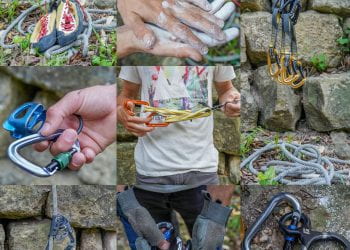
Sport climbing essentials (not pictures: harness) at St. Edward'
Left to right: 1. Rock shoes 2. chalk (climbers use this to help grip holds) 3. quickdraws 4. belay device used to control the rope) 5. runners (essentially an extension chord) 6. ascender 7. belay device 8. figure 8 (used to descend)
-
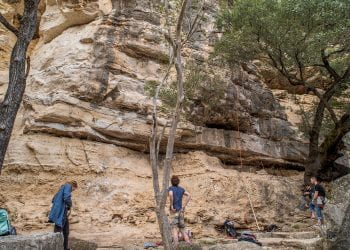
New wall when the weather cleared up at the Barton Creek Greenbe
It is highly reccomended that climbers wait at least 24 hours after rain to climb safely. This section of limestone just a 10-15 minute walk from the Barton Creek Greenbelt’s Spyglass trailhead is called New Wall, and climbers eagerly approached newly dry rock on a Friday afternoon. The Greenbelt has routes of all difficulty levels and is more polished than any other climbing areas in the Austin area.
-

Climber securing rope in his harness before ascending at the New
Before Clint starts to climb, he clears his head of all possible distractions. He imagines a blank canvas to fill. Then, flip: his head switches to climbing mode. “You have to be really in the moment when you climb so you don’t second guess yourself and lose flow. It’s kind of like taking a deep breath before you sing a song. Once you start you’re on a smooth, tight schedule until the very end; and the goal is to perform the song .. perfectly.”
-
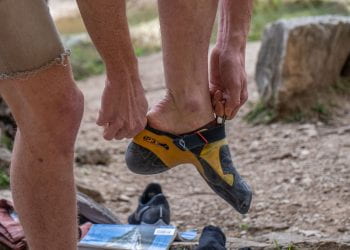
Climber changing into the propper shoes for outdoor climbing at
Before Clint starts to climb, he clears his head of all possible distractions. He imagines a blank canvas to fill. Then, flip: his head switches to climbing mode. “You have to be really in the moment when you climb so you don’t second guess yourself and lose flow. It’s kind of like taking a deep breath before you sing a song. Once you start you’re on a smooth, tight schedule until the very end; and the goal is to perform the song .. perfectly.”
-
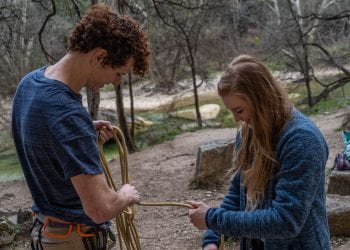
Partners untangle climbing rope before belaying eachother at the
Clint prefers to be belayed by a close friend or his significant other, Caitlin, because belaying requires a lot of trust. Clint pointed out that although belaying is often seen as a “behind the scenes component to climbing,” it is undeniably the most important component. The belayer is the person that supports the climber, literally, by feeding and holding the rope as the climber ascends and descends the rock.
-
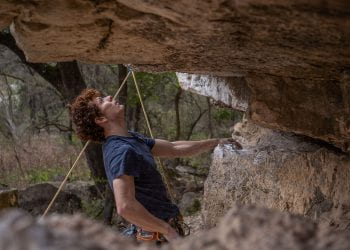
Climber plotting a route towards the bottom of the rock at the B
Clint Stepp began climbing at a small climbing gym on UT campus. Those first few months of climbing were riddled with injuries, according to Clint. “Eventually I learned how to push myself without injury,” Clint said. Although Clint has climbed in Mexico, Utah and Nevada, he says that no place compares to exposure, local environment, or the people on Austin’s rock walls. “Climbing in cool locations is one thing,” Clint began, “but climbing walls in the natural land of your home town really lets you connect with Austin, Texas. I wouldn’t trade my greenbelt for any other place in the world.”
-
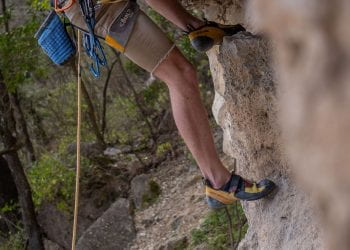
Climber executing plotted route at the Barton Creek Greenbelt o
Typically Limestone is well cemented, forming a hard durable surface for climbing, accoring to 3 Types of Rock for Climbing: Granite, Sandstone & Limestone by Stewart Green. Limestone also generally resists erosion, which causes it to form long cliff bands.
-
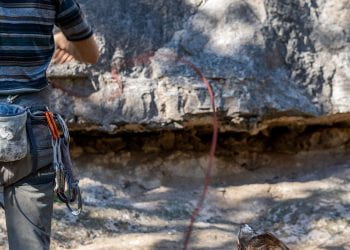
Climber and friend untangle rope on the Barton Creek Breenbelt on
A climber with a dog is not an uncommon sight. at the Greenbelt. Dogs are not allowed to be off the Greenbelt. The fine is $180 or a "Responsible Dog Owner" class; but according to Austin Climbing, this law is selectively enforced.
-
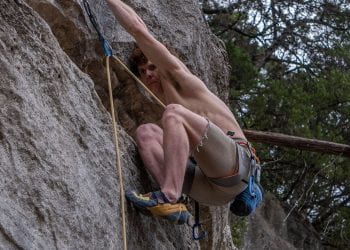
Climber grips holds as he plots next move at the Barton Creek Gr
Gus Fruh is a wall on the west bank of the Greenbelt. it is much more open than surrounding areas. According to Austin Climbing, this area is tricky to climb, and requires some exotic moves. In this area, insects have been known to burrow, producing a silky powder that aids climbers in gripping holds.
-
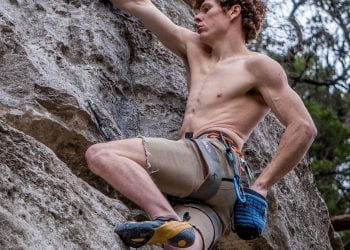
Climber reaches for chalk at the Barton Creek Greenbelt on 2/1
Gus Fruh is a wall on the west bank of the Greenbelt. it is much more open than surrounding areas. According to Austin Climbing, this area is tricky to climb, and requires some exotic moves. In this area, insects have been known to burrow, producing a silky powder that aids climbers in gripping holds.
-
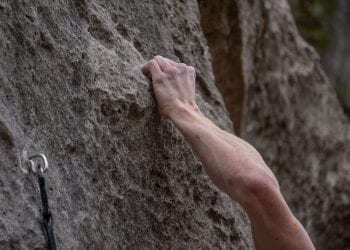
Climber performs the Crimpat the Barton Creek Greenbelt on 2/12/
A hold on a route is a part of the rock you can hold onto while climbing. There is a variety of ways to grip holds based on their shape and size, and each type of hold has a name. Local climber Aidan prefers smaller holds, like crimps, because they are more reliant on your fingers than other grips.
-
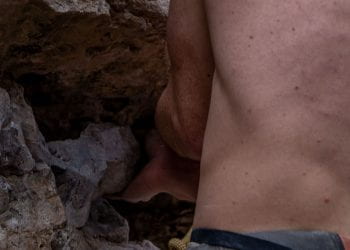
Climber performs the undercling at the Barton Creek Greenbelt on
A hold on a route is a part of the rock you can hold onto while climbing. There is a variety of ways to grip holds based on their shape and size, and each type of hold has a name. Local climber Aidan prefers smaller holds, like crimps, because they are more reliant on your fingers than other grips.
-
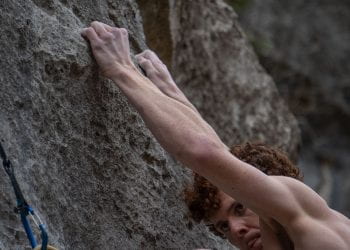
Climber grips holds as he plots next move at the Barton Creek G
When Clint begins to feel tired, he gets tunnel vision: “Nothing else matters, except me and the moves I’m making.” Clint said he relies on his instincts to keep him safe, but ultimately refuses to give up regardless of those instincts: “I always think of a quote by Muhammad Ali when I feel like giving up: ‘I only start counting when it starts hurting, because they’re the ones that really count.”
-
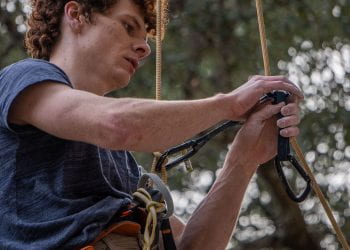
Lead climber mid clip at the Barton Creek Greenbelt on 2/12/2019
When lead climbing, a climber is attatched to a rope using a specific secure knot on the harness. As the climber ascends the rock, the climber will use carabiners to clip their rope to hooks bolted on the rock. The climber will unclip from the bolts as he or she descends the rock.
-
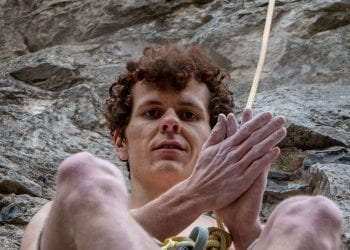
On-route resting point at the Barton Creek Greenbelt on 2/12/201
“Mother Nature did an excellent job of setting some amazing routes on the natural walls of the area,” Clint described the climbing areas in Austin’s Barton Creek Greenbelt as having “unique and unforgiving” moves required for a lot of the routes. In the book Austin Climbing, John Hogge describes the Greenbelt as “a great workout” because a lot of routes require the climber to climb on to ledges and over blocks.
-

A climber prepares to belay his sister on the Terrace at the Bar
The Terrace is accessible by Barton Spylass, and holds a combination of beginner and intermediate roues.
-
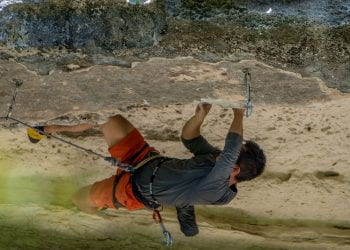
Lead climber on Seismic Wall at the Barton Creek Greenbelt on 4/
Seismic Wall is closest to the 360 access point of the Greenbelt. The route was bolted by local climber Tommy Blackwell.
-

Lead climber on Seismic Wall at the Barton Creek Greenbelt on 4/
Seismic Wall is closest to the 360 access point of the Greenbelt. The route was bolted by local climber Tommy Blackwell.
-
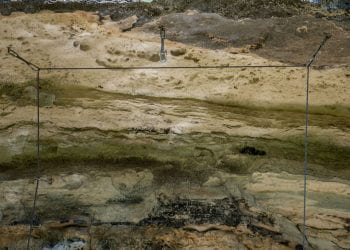
Tommy's bolts on Seismic Wall at the Barton Creek Greenbelt on 4
Most of Austin's rocks were bolted on the 1980s, according to Austin Climbing. According to Oxford's BioScience magazine, Vol. 49 Issue 7, bolting rocks may accelerate weathering of cliff faces. may accelerate weathering of cliff faces.
-
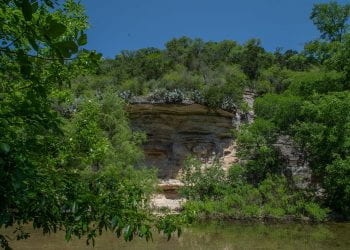
Seismic Wall from accorss the creek at the Barton Creek Greenbel
This isn't climbing's only negative impact on the environment. According to Oxford's BioScience, there is simply no way that climbers can get up walls without affecting plant or vertebrate communities. This issue is only enhanced by the fact that "peak rock-climbing season corresponds with the fruit and flowering season for plants and the breeding season for birds" (BioScience).